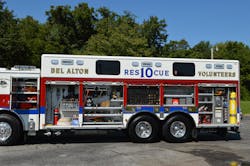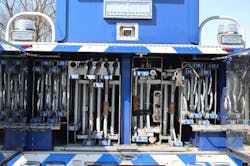The Apparatus Architect: Challenging ‘Times’ for Apparatus Purchasing
The following scenario has played out several times with departments of all sizes, affecting their scheduled apparatus fleet replacement: The appointed members of the department’s apparatus committee had numerous meetings to determine the mission of a new vehicle. They attended trade shows to review several manufacturers’ designs. They had individual sessions with sales personnel. The committee took its time to develop the technical specifications for the new apparatus. Along the way, it confirmed with the city’s purchasing agent the approved budget. After months of work and numerous revisions to the draft specifications, the final version was sent to prospective manufacturers.
On the day of the bid opening, the apparatus committee was pleased to find that it received multiple proposals for review. However, after an initial analysis of the proposals, only one of the bids was within the committee’s budget, and that one took total exception to the specifications and offered a stock vehicle that only vaguely resembled the apparatus that the department sought.
If this situation sounds familiar to you, it likely is because the cost of new apparatus has outpaced the capability of departments to adequately fund their fleet replacement program.Post-pandemic delivery
With few exceptions, the annual cost increase for new apparatus typically has been 3 percent–5 percent and took effect early in the first quarter of each year. Additional increases occurred from 2008–2010 because of changes in engine emission technology, the effect of the requirements of NFPA 1901: Standard for Automotive Fire Apparatus and inflationary pressures.
Fast forward to the present and numerous external factors affect new vehicle costs.
Prior to the pandemic, orders for new apparatus rebounded, and most manufacturers enjoyed a strong backlog of work. During the ensuing 24 months, a number of compounding events, including reductions in the workforce and supply chain delays for major components, resulted in extended delivery times. The traditional 10–12-month production time after contract has increased to 18–20 months or longer.
The longer delivery times affect department planning. Older vehicles that were projected to be retired and removed from service still are in front-line service, which increases maintenance and repair costs. In some cases, replacement parts no longer are available. Some must be custom-fabricated to keep vehicles in serviceable condition.
For apparatus builders, it’s difficult to project material costs because of the volatility of the marketplace and the inability to obtain vendor parts on a reliable basis to support the production schedule. The resulting effect has been a sharp increase in the final cost of new apparatus, an amount that’s far beyond what the industry experienced in the past several decades.Increased consortium benefits
Although there is little that fire departments and apparatus committees can do to negate these price increases, there are things that can be accomplished prior to going out to bid for new rigs. Depending on what method your organization utilizes to award a contract for new vehicles, several strategies can provide strategic information during the specification development process. Many departments utilize a nationally recognized purchasing consortium, such as Houston-Galveston Area Council (HGAC) and Sourcewell, to obtain detailed pricing on their apparatus prior to the final revision of the technical specifications. This enables the department to balance the requirements of the specifications against the planned budget for the acquisition. The advantage here is that committee decision-makers can view the costs for both the standard and optional components on the apparatus to determine the relative worth of a component versus the requirement to have it on the new vehicle.
When setting out to develop specifications, the apparatus committee should develop a condensed bullet list of the major design features and components that are required for the new vehicle. This information should be shared with prospective manufacturers’ sales personnel to determine whether the proposed configuration is within engineering parameters. This also paves the way for an initial cost estimate, to confirm that the budget for the new apparatus project is adequate.
Communities that require capital projects to be publicly bid have the advantage of soliciting multiple bids. However, without the benefit of using a purchasing consortium as the contracting agency, you only will have visibility to the total cost of the apparatus.
Another consideration: Whichever process that your department utilizes, unless you develop specific requirements for bidders to include testing, warranty terms, and details regarding delivery, acceptance and payment, you are subject to adhering to the manufacturer’s standard terms. In most cases, these favor the interests of the manufacturer, which might not be in the best interests of your department, particularly with respect to warranty coverage and terms of final payment.Technical documents
The importance of obtaining other technical documents from prospective manufacturers is increased during these particularly challenging times for apparatus purchasing. Chief among these are weight and electrical load analyses and turning radius and engine performance scans. For example, the latter show acceleration rate and time required to reach specific benchmarks that are required by the department. This information also is useful to determine prior to the bidding process the different rear-axle ratios, based on the desired gradeability and the top speed that’s required.
These documents provide an accurate depiction of the performance of the vehicle. Perhaps more critical nowadays, they can reduce the identification of costly changes, such as overweight axles, improper size of alternator and vehicle gradeability issues, at the preconstruction conference.
Supply chain issues
Any fire apparatus design is an amalgamation of hundreds of component parts. Some are vendor items; others are fabricated and installed by the final stage manufacturer. Because many builders adopted just-in-time production planning, the importance of the shipping and delivery systems to support the build schedule increased. For this reason, the availability—or lack thereof—of outside vendor components, such as axles, engines, wiring harnesses, pump panel instrumentation and water tanks, affects the capability to maintain the planned production schedule.
Additionally, manufacturers must absorb unplanned price increases for any vendor-supplied equipment for vehicles that are in production. At some point along the way, this affects the overall cost for new apparatus and the availability of replacement parts for units in the fleet.
When developing the requirements for any new apparatus, the committee should consider the difference between must-have and nice-to-have. The importance of a well-engineered rig can’t be overstated, but there are significant cost differences between, for example, medium-block vs. large-block diesel engines. The selection of one engine over the other also affects the choice of transmission, driveline equipment, front axle, suspension and tires.
During the specification process, when meeting with sales representatives, committee members should discuss various options and their effect on the overall cost of the vehicle. This is particularly important for major components, such as foam systems, generators, light towers and auxiliary scene lighting. Combinations of these systems, although needed in some applications, can add thousands of dollars to the final cost of the new apparatus—and add to the frequency of maintenance repairs and vehicle out-of-service time.
It might be beneficial to list some of the more significant components that add incremental cost to the apparatus as detailed stand-alone options. In this way, the cost for each item clearly is identified. Regardless of the procurement system that’s utilized, this concept allows the department/apparatus committee to individually consider options for inclusion and enable some cost-justification for the items. This also enables validation when comparing costs from vendors during the bid review process.
New normal
Specifying and purchasing new apparatus is a detailed process that requires apparatus committee members to spend the requisite time to read all of the technical submissions, including the long verbiage specification. This document becomes the contract material that guides the build for the vehicle. Detailed preconstruction meetings provide the ability to fine-tune overall design and should result in minor changes and enhancements to ensure that the new rig will enhance the department’s operational capabilities. The importance of all of this never has been greater than it is now, when delivery times are extended.



